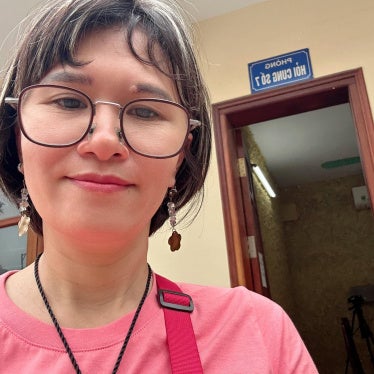(New York) – The Cambodian government should invite the United Nations human rights office in Cambodia to investigate the well-organized, brutal assault on two opposition members of the National Assembly on October 26, 2015, Human Rights Watch said today.
Early on the morning of October 26, several thousand “protesters” gathered outside Cambodia’s National Assembly building in Phnom Penh to demand the removal of Kem Sokha, deputy leader of the opposition Cambodia National Rescue Party (CNRP), from his post as National Assembly first vice-chairman. Sokha has repeatedly been denounced as an “extremist” by Hun Sen after Sokha asserted that the ruling Cambodian People’s Party (CPP) would lose the next national election in 2018. The protesters assaulted two CNRP parliamentarians, Kung Sophea and Nhay Chamraoen, dragging them from their cars as they attempted to leave the area and then beating and stomping on them, inflicting serious injuries.
Later that day, several hundred protesters arrived at Sokha’s home in northern Phnom Penh and hurled rocks and bottles. Sokha was not home at the time, but his wife was inside and could not leave. The police, who routinely and at times violently obstruct or break up peaceful demonstrations led by the opposition, took no effective action to stop the violence. Repeated calls to the Ministry of Interior to intervene and disperse the crowd went unanswered.
“Using a mob to attack opposition members of parliament sends a chilling signal to Cambodians that a new wave of political violence can be unleashed anytime and anywhere,” said Brad Adams, Asia director. “This ugly incident is the same kind of crude political violence used against the opposition in the 1990s to fend off challenges to Hun Sen’s one-party rule.”
Since the fraud-ridden elections of 2013, Prime Minister Hun Sen has repeatedly warned the opposition to expect demonstrations against it. He recently said that an opposition victory in the next election could lead to civil war, and warned CNRP President Sam Rainsy that he is at risk of being jailed.
Witnesses implicated elements of the Prime Minister’s Bodyguard Unit Headquarters (“Bodyguard”) in civilian dress as core participants in the demonstrations both outside the National Assembly and at Sokha’s residence. They recognized Bodyguard personnel among the crowd and identified them by the distinctive red Bodyguard motorcycles they used as transport. Observers also identified among the protesters non-uniformed members of units under the Phnom Penh Municipal police, including regular and para-police, the latter commonly used as a shock-force against opposition gatherings. Many of the protesters told observers that they had come to Phnom Penh from Kandal province, where Hun Sen maintains his personal residence and his Bodyguard is located.
The call for the removal of Kem Sokha was publicly backed by Gen. Kun Kim, a CPP Standing Committee member who is chief of the Cambodian armed forces and for whom Kandal is a long-time power base. The Phnom Penh police commissioner is one of Kun Kim’s key protégés and a CPP Central Committee member.
Many of the demonstrators were wearing pieces of red cloth, a marker that CPP-controlled vigilantes in civilian clothes have operated with since at least January 2014, when they participated in the break-up of a peaceful opposition gathering at Phnom Penh’s “Democracy Plaza” (also known as Freedom Park). Some were armed with slingshots, a weapon of choice for such forces for several years. Some were masked.
The violence against the two parliamentarians is similar to the CPP’s use of “reaction forces” in the early 1990s to attack opposition political parties. In line with this method of operations, as documented by the United Nations Transitional Authority in Cambodia and the Cambodia Office of UN High Commissioner for Human Rights, reaction forces present themselves as ordinary citizens enraged at the opposition, when they are in fact organized and sent into action by the CPP leadership.
A repeated pattern during deployment of reaction forces has been for some elements to act in a particularly violent manner, while others stop at verbal abuse and threats. Another part of the reaction force formula, again documented by the UN and others, is for the CPP to pretend to investigate reaction force violence, but only in order to cover up its own involvement. In this instance, Hun Many, a son of Hun Sen who is a member of the National Assembly, has condemned the attack on his fellow parliamentarians and called on those responsible to be punished.
“Unless there is an independent investigation and subsequent prosecution of those responsible for this vicious attack, there is every chance such violence will be repeated and perhaps even escalate,” Adams said. “Cambodia’s donors should not only denounce this attack, but they should insist that the ruling party cease the use of violence against its political opponents.”








